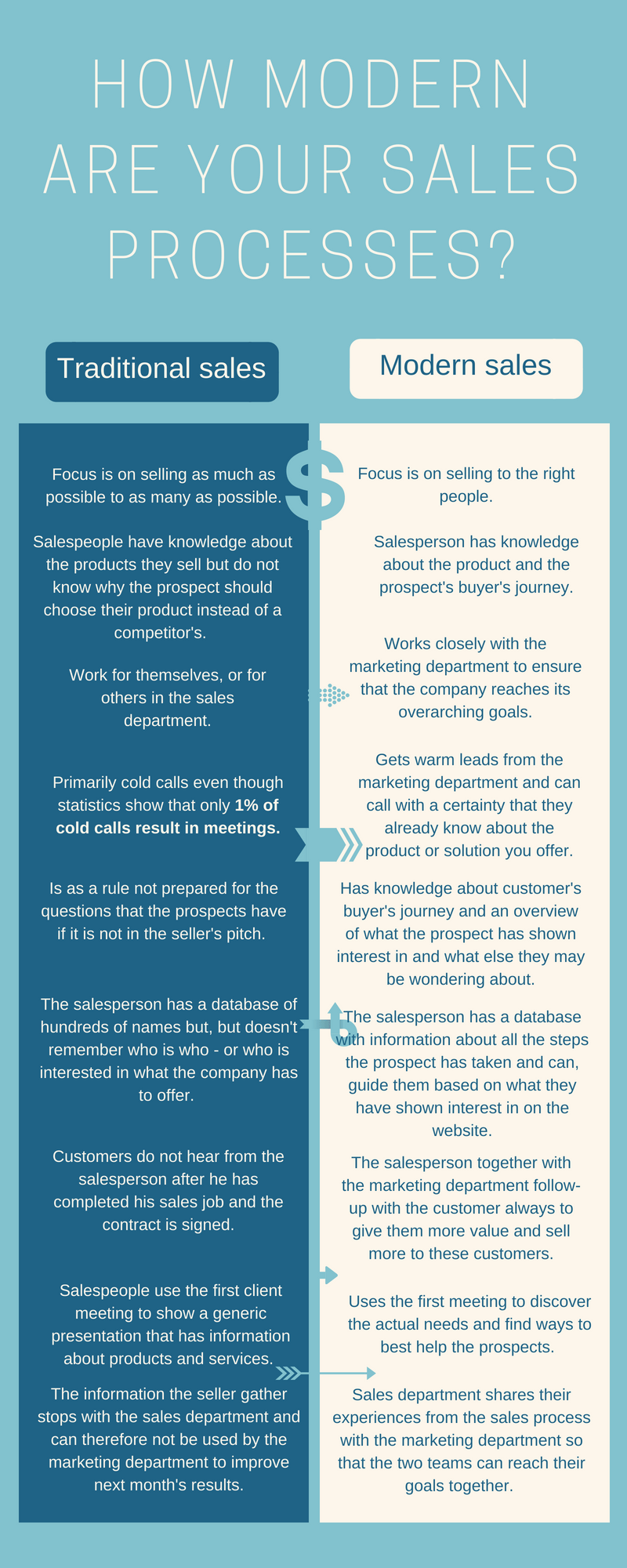[Infographic]: How modern are your sales processes?
Are you one of those salespeople who still cold-calls people on bought call lists, or do you take pride in selling only to those people who are a good match for your business – and who will actually benefit from buying your product or service? Find out how modern your sales processes really are using our infographic.
There are many benefits of modernising the way you sell. Not only will you sell more, but you will also have a much nicer sales day where you communicate with people who are actually interested in listening to what you have to say.
Could it be that you are already on your way to becoming a modern salesperson? Psst: You will find more in-depth explanations of what a modern sales process looks like in the infographic.
Infographic: How modern are your sales processes?

Modern sales VS traditional sales
Modern sales

1) Focus on selling to people who are a good match for the company and who can become a good partner and ambassador.
As a modern salesperson, you help prospects solve their problems and challenges. If you choose to sell your product or service to someone and it is not the optimal solution, it is very likely that the customer’s needs will not be met and that you will end up with a dissatisfied customer.
Therefore, use your skills to sell only to those customers that you think will be a good match for your business. This way, you will get satisfied customers who can recommend you to their networks.
2) The salesperson has knowledge about the product and the prospect's purchase.
As a result, you are well prepared when you first pick up the phone and contact the prospect, and know exactly which questions to ask and which buttons to press. After all, you have information about the entire buyer’s journey the lead has had and what interests him along the way.
3) Collaborates closely with the marketing department so that the company can achieve its overall goals.
Within inbound sales, there is a method called sales enablement. This method entails a collaboration between the marketing and sales department to ensure that both departments achieve the best possible results. One thing you can do is to produce "sales content" that can be crucial towards the end of a sales process. Such content may be:
- Customer stories (case studies)
- Whitepapers and e-books
- Product demos
- Price and discount information
- Checklists
- Templates for emails and offers
Creating and using this content can make any sales team more efficient because the prospects they are talking to are more enlightened and knowledgeable, but also because the content has helped to build the business as a trusted industry expert.
4) Get warm leads from the marketing department and call the prospect with the certainty that they already know about the product or solution you offer.
When you pick up the phone and call the prospect, you know that the person you are talking to already has an interest in what you offer because the lead has given your company their contact information on your website.
5) Has knowledge about the customer's buyer’s journey and therefore has an overview of what information the prospect already have, what they have shown interest in and what questions they might have.
6) The salesperson has a contact database with information about all the steps the prospect has been through. He can thus guide the prospect based on what he has shown interest in on the website.
7) The salesperson along with the marketing department follow up with the customer to continuously deliver added value and sell more to these customers.
8) Uses the first customer meeting to uncover real needs and find out how he can best assist the prospect to meet the need, solve the challenge or reach the goal.
9) The sales department shares the information they receive directly from the prospects and the experience they gain in the communication with prospects, with the marketing department so that the two departments can help each other achieve their goals – thus reaching the overall goals of the company.
As a rule, salespeople know most about how prospects think because they can make them think out loud during the sales process. The information that the salesperson then receives can be taken back to the marketing department. Using the information you get, you can easily understand when and how trends in the buying process change so that the entire business can adapt accordingly.
Traditional sales
/Magisk%20tal%2060%20-%20b2b%20virksomheder.jpg?width=800&name=Magisk%20tal%2060%20-%20b2b%20virksomheder.jpg)
1) Focus on selling as much as possible to as many people as possible. It's not that important who you sell to as long as you sell.
2) The salesperson has knowledge of the product they are going to sell (but not why the prospect should choose this product rather than the competitors’ products.)
3) Work for themselves or others in the sales department.
4) Mainly uses cold calling as a strategy even though statistics show that only 1% of cold calls result in meetings.
5) Is usually not prepared for questions the prospect may have if this falls outside the salesperson's pitch.
6) The salesperson has a contact database consisting of hundreds of names but does not remember who is who – or who is interested in what the company offers.
7) The customer does not hear from the salesperson after completing his sales job and the contract has been signed.
8) The salesperson uses the first customer meeting to show a generic presentation that contains information about products and services. He forgets to investigate what the customer actually needs before attending the meeting.
9) The information the salespeople get from customers and prospects stops in the sales department, (and therefore the marketing department do not benefit from the information to create even better results next month.)

Real Growth. Real Impact.
HubSpot for startups: Leveraging the platform and unlocking growth w. Ragini Campion
Making AI adoption not a big deal with Mike Kaput from The AI Show
HubSpot's Spring Spotlight 2025 was not what we expected
The Power of Community in Marketing
The Return of Human Marketing in an Automated Age | Avidly Talks
How to make change projects a success - Change management tactics
How to prompt AI for great creative ideas
See why enterprises choose Avidly
Let’s build your HubSpot success story
Compelling final call to action - with accompanying link to Contact page







